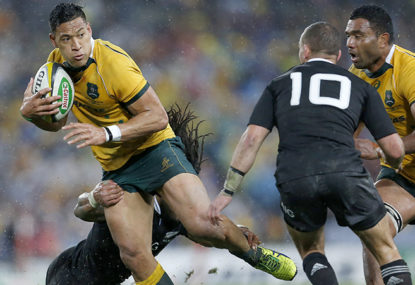The game they play in heaven: A 'Dream XV' made up of unforgettable players
Unfortunately, the only criteria for this Dream XV are that you had to have passed away. During my research, I thought of potential players…

With seven wins and a draw from their previous eight games, Australia to be sure was enjoying a good run, but the carnage at Eden Park exposed their flattery as so much deception.
And while only so much blame can be laid at Ewen McKenzie’s door, he has seldom looked more a prop than when selecting the Wallaby backline for this year’s Rugby Championship. Or it could be that he felt threatened by Michael Cheika’s success with the Waratahs, and so deemed it necessary to put his own stamp on the Wallabies by diluting the Waratahs’ imprint.
The irony being that he while he was probably right to do so, he did it arse-backwards. He proved he is his own man by ignoring the best halfback combination in the land in 2014 and instead pairing a pedestrian journeyman at No. 9 with a brilliant but headless and out-of-position chook at No. 10.
To be fair to MacKenzie, piecing together a complete Aussie backline at the moment is no easy task; either because some of the pieces don’t quite fit, or because they don’t exist at all.
But at least he could have got the easy ducks in a row – i.e. Israel Folau, Bernard Foley and Nic Phipps (though note that while Phipps might be the best No. 9 available at the moment, it is hard to see him as the final answer) – and thus freed up his time to concentrate on the difficult stuff.
Difficult stuff such as what, really, should be done with Kurtley Beale?
As much as Beale in his pomp is a delight to watch and a danger to any opposition, he is too much of a risk to include in the starting XV.
Once upon a time in Tests, and still at Super Rugby level, a weak defender could/can be protected, but in the current international game if you can’t be trusted to tackle you can’t be trusted to start. As so many others have said, Beale’s creativity can be the difference once the game starts to break up, but if you have to move players around between defence and attack because you can’t rely on a player to stand his ground then that ground is already sliding under your feet.
With Beale out of the picture, Matt Toomua starts at inside centre, pretty much by default. Not one to set the world on fire or send shivers down opposition backs, but reliable enough to not let the side down until someone else comes along (or he grows into the role).
Adam Ashley-Cooper’s form for the Waratahs in Super Rugby would seem to give him the inside running for outside centre, however the gap between Super Rugby and Test rugby would seem to also be the gap between him having and not having a passing game.
So Tevita Kuridrani comes into centre and Ashley-Cooper goes to the wing. Which is handy, because Australia doesn’t have any wings, and fewer by the week. Rob Horne, as last-man-standing, keeps his place until Henry Speight is available or some fresh blood is sprung from another code.
As for the forwards, where McKenzie is more in his comfort zone, the problem at Eden Park appeared more fortitudinal than selectorial, though Wycliff Palu was once again exposed as a flat-track bully.
The All Blacks combination of aggression and pace proved too much for him and he went remarkably AWOL, to the point where it is hard to imagine him being chosen to run out against the South African loosies this Saturday.
Scott Fardy was a bit better but he too needs to up his game; Michael Hooper was left with far too much to do on his own, including providing leadership, for a man of his size (and experience). Looking at the forwards as a whole across both All Black games, the whiff of déjà vu was strong, as for years now, the fatties might make a proper fight of it one week but are then left without enough in the tank to produce a repeat performance the next.
Ultimately, there is a clear sense that while Australia was well served this year in the Super Rugby, it is still struggling with the step up to Test rugby, in terms of both depth and delivering consistent intensity.
The cracks can be papered over on an occasional basis (as against the All Blacks in Sydney), but fronting up on a week-in, week-out basis against the toughest opposition remains a problem. And while the direction of travel since this time last year is positive, and there is no team that the Wallabies can’t beat on a one-off basis, it is hard to imagine them emerging triumphant from next years’ World Cup.
The Group of Death is eminently negotiable, but to follow that up with three knock-out victories back-to back looks at least one bridge too far, no matter how good a selector MacKenzie has by then become.